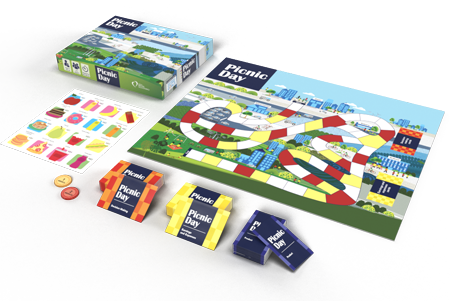
At least two, at most six people, each with a colored pawn.
Yes, but it will take longer to finish the game.
No. The player who ends up with the most money after buying all the items on the picnic list wins.
As stated in the rules, players can choose the products freely. But you can – and should – show them that, as in real life, choosing diversified products also suits personal taste and can bring advantages with decision-making cards (red). Make them realize that it is worth getting discounts and looking for sales in order to diversify into products (and prices), and that choosing the “cheapest products” does not necessarily provide the player with financial benefits.
No. When two or more players end up with the same amount of money after buying all items on the list, arriving first is a tiebreaker criterion.
No. Each player draws only one card per round. If, after moving forward or backward, you land on a yellow or red space, your turn ends.
Wait for your next turn to play.
Yes, in this case it is mandatory to buy it.
Yes, after being used, the yellow cards should always return to the bottom of the deck of yellow cards arranged on the board.
It depends on the card. Some cards state that the player must keep it until the end of the game, others relate to an immediate decision and, after the player reads it and makes a decision, the cards must return to the bottom of the red card deck on the board.
No. This applies only to two types of red cards that expressly state that they must or can be kept for use at the end of the game. All the other cards, both red and yellow, must return to the bottom of the deck on the board, according to the color.
Product cards are distributed at the end of the game according to each player’s individual list. It so happens that some products may be bought during the game (depending on the content of some red cards).
If there are no more cards of the chosen food left, another item of the same value must be chosen. This does not harm the player (the player will have the same expenses as provided for the shopping list).
In this case the result does not change. For the purpose of the game, only the products on the list prepared change the result.
In this case, when you arrive at the end of the game, you will not need to buy these products.
Yes. Once everyone has arrived at the end, they start buying the products on the list and calculating how many Americas each player has left.
No. The goal is to buy the 4 products specified in the list exclusively during the rounds, and the players shall not conduct any negotiations among themselves. By following the rules of the game, the players gain enhanced knowledge of financial education, since we are talking about executing a plan.
Yes, as long as they follow the same value bases (A$1 to A$4) and the other rules of the game.
No. When the player crosses the finish line, their participation in the game ends. They will only have to wait for the others to finish as well, so that everyone can begin buying items on the lists prepared.
The games were designed to achieve an effective learning in financial education, and the rules have been thought out by experts for this purpose. However, the board circuit and random use of cards can inspire you to create other pedagogical possibilities from this concept.
No. Picnic addresses issues such as nutrition, environmental education, kindness, urban mobility, among others. See the lesson plans and use your imagination to create many pedagogical and interdisciplinary possibilities.
It is a game for the entire family that can be used both in after-school activities and within traditional subjects in an interdisciplinary manner as proposed by the National Common Curriculum Base (BNCC). Many adults have fun while learning about finance and the importance of saving to achieve a goal (in this case, buying the selected items and having spare money).
